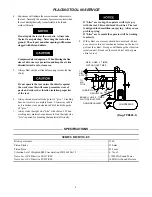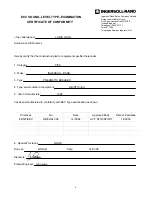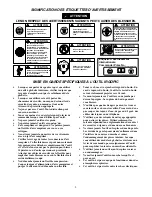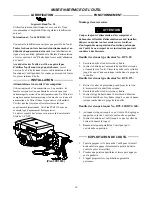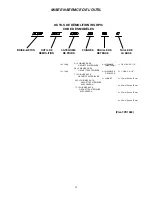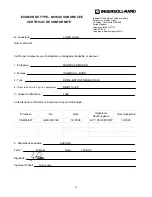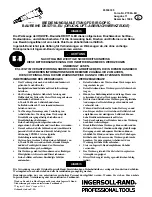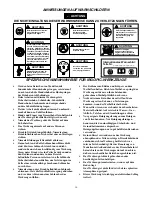
4
PLACING TOOL IN SERVICE
4.
Experience will indicate the correct amount of pressure to
the tool. Normally, the amount of pressure is correct when
the tool hits rhythmically, is comfortable to hold and
works efficiently.
Do not repair the tool at the work site. Always take
the tool to a repair shop. Never drag the tool on the
ground. The air port and other openings will become
clogged with dirt and debris.
Compressed air is dangerous. When blowing the line
clear of dirt, wear eye protection and keep the air line
directed toward a safe, clear area.
5.
Always blow out the air line before using to clear the line
of dirt.
Do not operate the tool unless the chisel is against
the work since this will cause premature wear of
parts and reduce the vibration isolation properties
of the tool.
6.
Always break material to the point of “give.” Cracking
does not result in a complete break. Clear away rubble
as it is broken since uncleared rubble blocks the point
of “give.”
7.
Always take the right size “bite” with the tool. When
working new material, experiment to find the right size
“bite” required for breaking that material efficiently.
If “bites” are too big, the operator will try to pry
with the tool. This could break the chisel. The tool
is designed for demolition, not prying. Always use a
pick for prying.
If “bites” are to small, the operator will be working
too slowly.
8.
If the chisel or accessory should become stuck, do not
use excessive force or mechanical means on the tool to
pull out the chisel. Doing so will damage the vibration
isolation unit. Break out the stuck chisel with a spare
chisel or tool.
MAIN LINES 3 TIMES
AIR TOOL INLET SIZE
TO
AIR
SYSTEM
TO
AIR
TOOL
LUBRICATOR
REGULATOR
FILTER
BRANCH LINE 2 TIMES
AIR TOOL INLET SIZE
DRAIN REGULARLY
COMPRESSOR
(Dwg. TPD905–1)
SPECIFICATIONS
SERIES DB/DT10–EU
Blows per minute . . . . . . . . . . . . . . . . . . . . . . . . . . . . . . . . . . . . . . . . . . . . . . . . . . . . . . . . . . . . 1560
Piston Stroke . . . . . . . . . . . . . . . . . . . . . . . . . . . . . . . . . . . . . . . . . . . . . . . . . . . . . . . . . . . . . . . 150 mm
Piston Bore . . . . . . . . . . . . . . . . . . . . . . . . . . . . . . . . . . . . . . . . . . . . . . . . . . . . . . . . . . . . . . . . . 42.5 mm
Vibration Level Weighted RMS Acceleration ISO 8662 Part 5 . . . . . . . . . . . . . . . . . . . . . . . . 6–7m/s2
Noise Level EC Directive 84/537/EEC . . . . . . . . . . . . . . . . . . . . . . . . . . . . . . . . . . . . . . . . . . . <108LWA Sound Power
Noise Level EC Directive 89/392/EEC . . . . . . . . . . . . . . . . . . . . . . . . . . . . . . . . . . . . . . . . . . . 100DB (A) Sound Pressure




